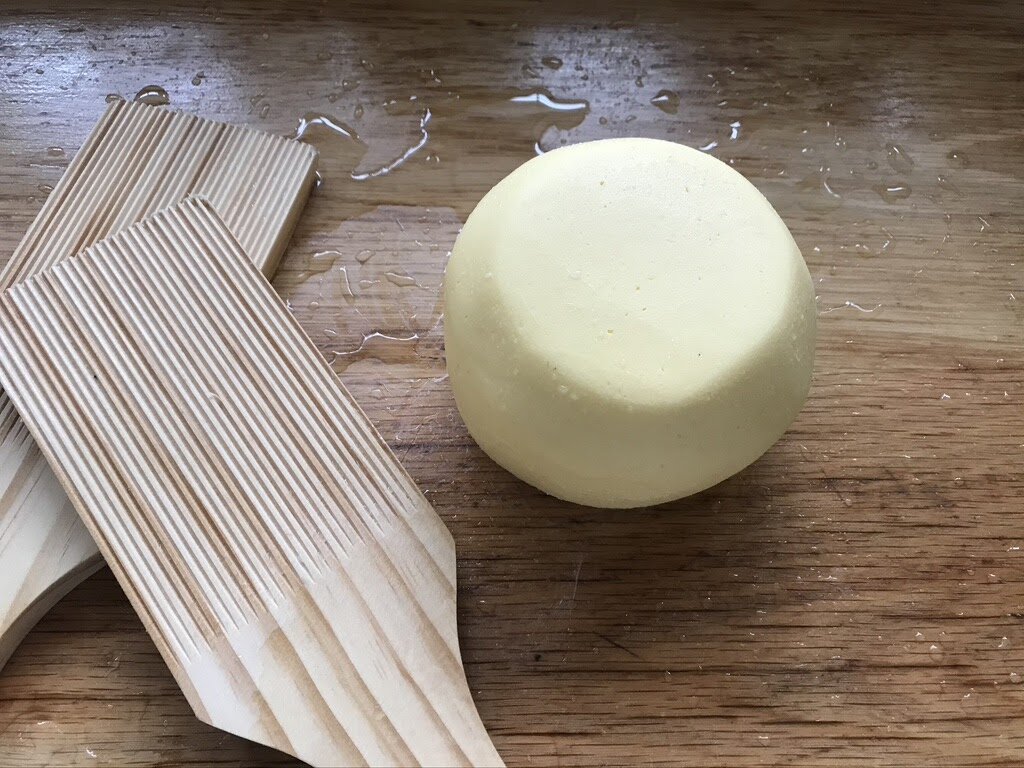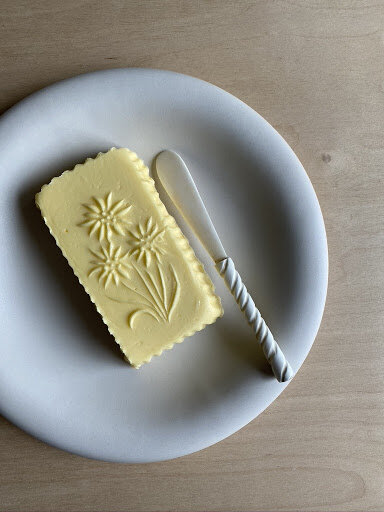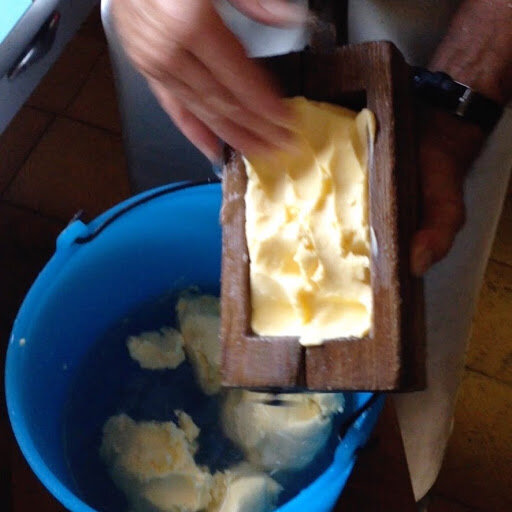Artisan Spotlight: Maria Van Zyl of Cream of the Crop Butter
I met many interesting people while studying in Italy at UNISG and it is awe inspiring to see the things they have gone on to do in the food world. Maria is one of these people! In catching up for this piece, it amazes me how you can spend a lot of time with someone and not know so much of their story. Frankly, it’s one of my favorite aspects of the Artisan Spotlights.
Maria is always quick to laugh and you somehow leave a conversation with her feeling lighter. I got to know her at school because of where she lived (in the home that held many of our school dinners/events) but hearing her story was eye opening. I love that she is keeping her matrilineal dairy traditions alive and yet, doing it on her terms and making it her own. Now it makes sense, given her upbringing, her look of utter confusion when I shared that I was headed back home to Chicago after the program. I imagine she was wondering why I would want to live in a big city after a taste of country life (that’s a great question that I’m looking to change ;)
Being largely dairy free, I would make an exception for Maria’s butter in a heartbeat because of her craftsmanship and focus on quality. The beauty of her products comes from simplicity with a few, thoughtfully sourced ingredients and the fact that it is handmade. A lot of love went into creating Cream of the Crop Butter and I cannot wait to taste it one day.
I have wanted to feature Maria since launching my website and I’m so happy it’s finally happened! And coincidentally, the timing is perfect in that Maria and Erin (of Seeds & Salt) are hosting a class to teach how to make butter this weekend. If you’re even mildly curious, sign up because you are in great hands with these two besties!!
Where did you grow up?
I was born in Somerset West, a town an hour outside of Cape Town. After a few years in the town my parents decided it was time to move to a farm. I spent most of my childhood on our farm in the Jonkershoek Valley. My mom grew a beautiful vegetable garden that she supplied markets and restaurants with the fresh biodynamic produce. We had a flock of chickens, two cows and it was here where my true love for farming and dairy was sparked.
How’d you end up at UNISG?
After I completed my internship at a bakery a few hours up the coast from Cape town I decided I wanted to study. I was exhausted after the long hours of working, getting up at 2am and finishing work just before that the following afternoon. My mom actually met a woman in South Africa who had just completed her masters at UNISG and told me about it. I applied for the scholarship and was so happy when I got it the second time around.
Tell us about your time at UNISG?
I thoroughly enjoyed my time at UNISG. It really is a place that one has to embrace and make the most out of for yourself. It is easy to get caught up in all the bureaucratic faults and miss the opportunity that is in front of you. I completed the three year undergraduate degree in 2019 and then went on to work in the Alps in Northern Italy for the summer.
Biggest takeaways from Slow Food?
During my time in Bra, I think it was the people I was surrounded by that truly made my time special and unique. Everyone was there for a similar reason. We all had a great interest in food.
Tell us about your internship?
After I completed my studies and my last exams I went to work in the Alps in Northern Italy. I knew a farmer who had a small herd in the Schleis Alm, which is above Bolzano. He mentioned that during the summer it was his holiday and his cows were spending 3 months in the summer pastures above his village. His father drove me up the mountain where I would stay for the summer. Every morning we would wake up at 4am. We would go and fetch the cows in the nearby pasture, all 50 of them, to bring them in for the morning milking. At 4:30 we would have a small breakfast and then begin milking at 5:00. After milking we would walk with the cows into the fields to graze for the day. Some days we spent all morning with them as we took them about 40 minutes down the valley. That summer was particularly dry and hot and there was a shortage of grass.
Why’d you choose to start a butter company?
I chose butter because it was the easiest way for me to start doing something with dairy without having my own cows. My dream is to have my own cows that I can feed a diet that is not based on GMO grains or food that is bought in.
Coming back to South Africa, I wanted to start making cheese however it proved difficult as I didn’t have the right facilities. Butter was the easiest option for me as I was able to purchase grass fed jersey cream from a farmer two hours away from where I live. I will begin making cheese soon and add it to my range of products.
Did your mom growing up on a dairy farm in Limerick, Ireland influence you in any way? Is this in your genes?!
I think so! My mom loves cows more than I do and was always there telling me to just go for it. She always spoke about my gran, her mom, who was the real milk queen. She made butter just for the family but most of the milk was sold off weekly to a rather large corporate milk system.
What do you currently sell?
At the moment I am selling cultured butter, double thick yoghurt, and ghee.
What exactly is cultured butter?
Cultured butter has an extra step before it is made. The fresh cream is cultured/inoculated with a live lactic culture and fermented. This can take anything from 1 day to 4. The milk sugars, known as lactose, are fermented and converted to lactic acid creating a thick cream the consistency of crème fraîche. The taste of cultured butter is tangy, crisp and fresh! Almost like biting into a fresh green apple with a soft and round flavour. My cream comes from a grass fed jersey herd a few hours outside of Cape Town.
What was the experimentation process like to develop your final cultured butter recipe?
I went through many trials and errors to get to the right flavour. I tested many methods of fermentation. I tried leaving the cream outside to ferment, as it wasn’t raw cream, but the fermentation was not great. I used yoghurt, buttermilk and kefir grains in my testing. I want to move away from using store bought freeze dried bacteria and found kefir a wonderful way to create a delicious fermentation. I made many different trials and eventually did a blind tasting with my family and friends and they decided.
Recommendations of how to use your butter?
The best way is 1:1 ratio on bread! It might be a bit much…. but I watched a French butter maker taste butter once and he allowed the butter to come to about 18/20C not too soft or melted. He dug his knife into the butter and just “spread” it on the bread leaving it like a wedge of butter on the edge of the bread.
Can you do a high level overview of “Making Butter 101”?
Start with fresh cream, about 500ml in a 1L jar. Shake it until you see the cream begin to thicken. Keep at it, it usually takes about 15/20 minutes and then you will slowly see the butter form into little pieces and lots of liquid, this is the real buttermilk. Pour the butter and buttermilk over a sieve into a bowl to catch the buttermilk. Begin to knead the butter together to form a ball. If it’s getting too warm, allow the butter to chill in an ice bath. When it is pliable like the consistency of clay it's the easiest to work with. From here you can add your herbs and spices to make a compound butter, as well as your salt. Wrap in baking paper and keep in the fridge.
What’s the story behind the molds?
The butter molds I am using today were a gift from the farmer I worked with in the Alps. I told him how much I loved them and he said I could take the ones he was no longer using. When I came back to SA, I started making butter and my friend Tessa came to visit me and brought a mold from Slovenia. This was actually the first mold I used to start making butter, it was the perfect size because I didn't want to be competing with the store bought butter sizes.
Originally butter molds were used to identify the farm where they came from. Each farm had their unique mold design that would indicate to the customer who made it, making it easier to choose the butter you really liked.
What difference does the breed of cow or cow health make in dairy products?
The breed offers a different composition of protein and butter fat. The jersey cow is great because it has a high content of cream which makes delicious butter. The food that a cow eats and the way it is looked after also factor into the flavor of the dairy product. When the cow is under stress, it produces an inferior quality product. Farms that congest their cows onto a small piece of land, or feedlot have a much lower quality.
What role does dairy play in South African food culture?
Dairy farms have been a large part of South African food culture. Along the East Coast of South Africa it is known as the dairy belt. This is where a large concentrated portion of our dairy industry is. The temperature is much more forgiving for dairy farming and has a great amount of rainfall.
Xhosa and Zulu have a much closer connection to cows as they form an integral part of the culture. Each family owns a cow and makes a delicious drink known as amasi. It's milk that has naturally fermented, as it is raw it has all the bacteria and yeasts to ferment in a positive way. Traditionally amasi was fermented inside dried out calabashes, each new addition of milk was added in the morning and the gourd was never washed out. Today it can be found in all supermarkets, however it is made with culture to ferment, the same way buttermilk is made.
What’s your opinion about people eliminating dairy from their diet for health reasons?
I totally understand that people are doing it. I have chosen which dairy to eliminate from my diet and that is the highly over processed commercial type. I choose and look out for dairy products that have been made by people who are connected to their animals, respect them and in turn make a delicious product.
How do you apply Slow Food principles to your business?
I found the principles held me back in some way. This is definitely a positive thing on one end however I truly considered everything before I made the product. I thought about the origin of the milk, cream, and salt. Particularly for the packaging, I considered reduced waste and a circular economy that used very little carbon emissions but in the end I couldn't find anything that was sustainable enough! I am very grateful that I have these pillars to guide me and keep me in check. They are considered in the way in which I do things, however it is very difficult.
I think it is essential to understand what the best ways to implement the Slow Food principles are within your context. The packaging I use is all made here in South Africa, which I realised was much easier. Especially in lockdown when the borders were closed and I ran out of packaging!
How has COVID-19 affected your business?
COVID-19, was the true start of my business! I know I am very lucky to be able to say that though. My job at the start of COVID was at a market, my salary was cut 75% as the market was closed down for the first 6 weeks of lockdown. I got a call on the day of the lockdown from a company that was starting online veg box deliveries. My first order was for 50 blocks and each week the number grew and grew. I went from those 50 blocks to almost 700 a week. I made everything in my house in Cape Town and the company gave me a table to work at in their factory. This was such a blessing as I didn’t have enough space to store all my buckets of cream and all the butter! After 5 months of working at their factory I decided to find my own space and now I share with a company that makes ice cream.
What’s in the future for Cream of the Crop Butter?
My goal is to have my own cows. I would love to have a herd of about 5/10 cows and only make enough product from what my cows produce. I want to move away from making orders on demand. I have developed a Community Supported Agriculture initiative that allows the customers to invest in their dairy supply. I have called it The Committed Value Chain. This has been met with an overwhelming response. People are truly very excited to be a part of a project that is not linked at all to the commercial dairy system. It has been in operation for almost three months and I now have almost 30 members that I deliver to on a weekly basis.
Can we learn to make cultured butter from you?
YES!!! I do online zoom workshops with my friend Erin and the next one is Sunday, March 7. We will be making cultured butter and fresh ricotta, and then use our creations to make gnudi, a delicate, spinach and ricotta dumpling with a lemony, browned-butter sauce. Buy tickets here!
(Erin, of Seeds & Salt who was the first artisan I featured!)
Where can we find you on the world wide web?
Currently I am only on Instagram @creamofthecropbutter and this is where I post about all the courses too.
Photos by Maria Van Zyl
Running to get bread and butter….brb 🤤











